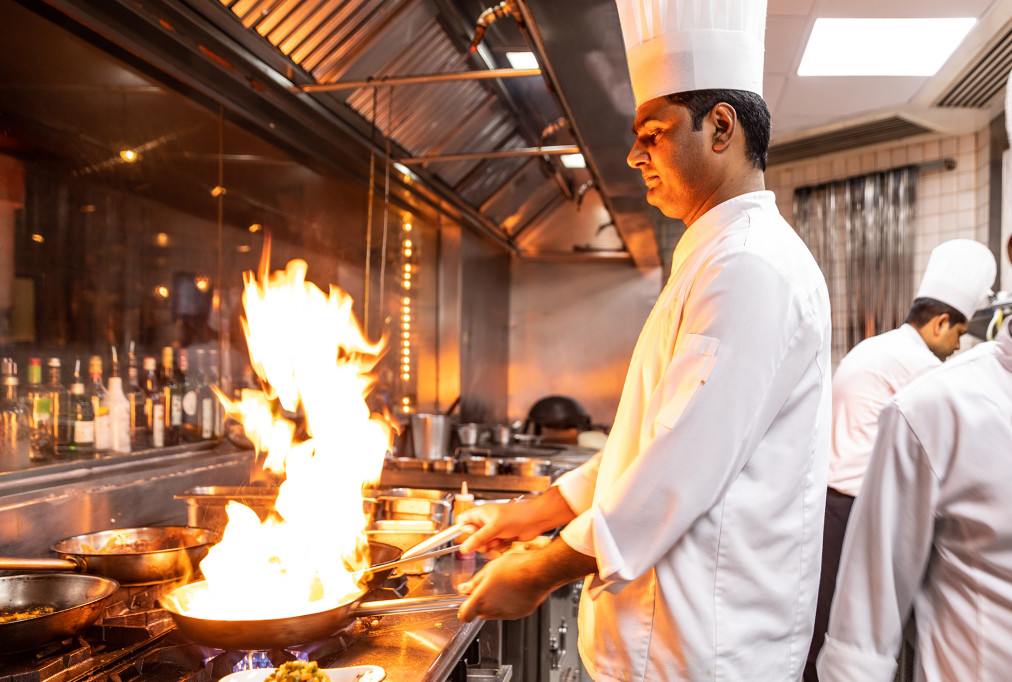Restaurants often generate excessive energy waste. Cut energy costs, improve the dining experience and save with these simple tips.
Savings Opportunities: Peak Demand Management
When you use energy is just as important as how much you use. Manage your demand or maximize your savings on a time-of-use plan by following these recommendations.
Plug Loads
- Turn off redundant equipment after “rush” times.
- Use sensors to turn off conveyor ovens when food is not present.
Long-Term Strategies
- Use a smart thermostat to reset space temperatures.
- Pre-cool your space before the peak hours of 1-5 p.m. Monday-Friday.
Savings opportunities can also be found in refrigeration, cooking, lighting and HVAC. Below are steps you can take to improve efficiency in each area of your food service business:
Refrigeration
- Purchase ENERGY STAR-certified ice machines, which use 15% less energy and 23% less water than other models.
- Keep freezers and refrigerators filled; empty and disconnect older ones.
- Provide adequate air flow around the condenser coils of refrigeration equipment and clean them regularly.
- Install strip curtains on walk-in coolers and automatic door closers on walk-in freezers to reduce air infiltration by 75%.
- Check and replace walk-in cooler and freezer door gaskets.
- Add high-efficiency Electronically Commutated (EC) variable-speed evaporator fan motors (which typically use 70% less energy) to walk-ins and reach-in refrigerators.
- Check refrigerant charge levels.
- Use on-demand hot gas bypass for condenser defrost.
- For new walk-in equipment, choose coolers and freezers with a high annual walk-in energy factor (AWEF) rating.
To learn how your business can save money on food service equipment, visit the LADWP Food Service Program website. If you have any questions, please email foodservice@ladwp.com or call 1-213-367-4134.
Kitchen
- ENERGY STAR-certified cooking equipment and kitchen appliances are 35% to 60% more efficient than standard models.
- Variable frequency drives control exhaust and intake air fan speed according to demand, saving energy.
- Replacing a 2.6-gallon, pre-rinse spray valve with a 1.6-gallon, low-flow model can save about 22,000 gallons of hot water per year.
In addition to the LADWP Food Service Program, the LADWP offers rebates for water conservation equipment. For more information please visit the Water Conservation Rebate Program website.
To learn how your business can obtain free water conservation items, send an email to waterconservation@ladwp.com or call 1-800-544-4498 and press "5."
Lighting
- Purchase indoor lighting with an 80+ CRI color quality rating.
- Replace fluorescent lamps with LEDs and save 30% or more.
- Take advantage of natural light to reduce the need for overhead lights.
- Install shade screens or window film to reduce solar heat gain.
- Use high illumination levels and high CCT color temperatures (over 4000K) for fast casual dining.
- Use lower illumination levels and lower CCT (less than 3000K) for fine dining.
- Install occupancy sensors in low foot-traffic areas.
- Turn off all lights in unoccupied spaces.
To see if your business qualifies for free energy efficiency upgrades visit the Commercial Direct Install Program (CDI) website or call 1-877-714-1254.
A Case Study in Restaurant Efficiency
A restaurant housed in a single-story building (built in the 1920s) has 7,500 square feet of casual dining space that seats 54, two 12-seat bars, and a 60-seat heated patio with a full bar. The kitchen hot line consists of four six-burner open range tops, a 50-lb deep fat fryer, and a manually-controlled griddle. During start-up, the restaurant invested in an ENERGY STAR®-certified countertop boilerless steamer and convection oven. It also purchased high-efficiency appliances (including freezer ECM fan motors and doorway strip curtains), exhaust hood ventilation control and low flow sprayers.
Financial Benefits
- More than $2,380 saved each year in electricity costs
- Decreased maintenance costs
Non-Energy Benefits
- Improved customer and employee comfort
- Reduced environmental footprint
- Lower water consumption
Source: Food Service Technology Center
LADWP offers many savings opportunities for businesses. For more information please visit LADWP.com or email SBS@ladwp.com.

